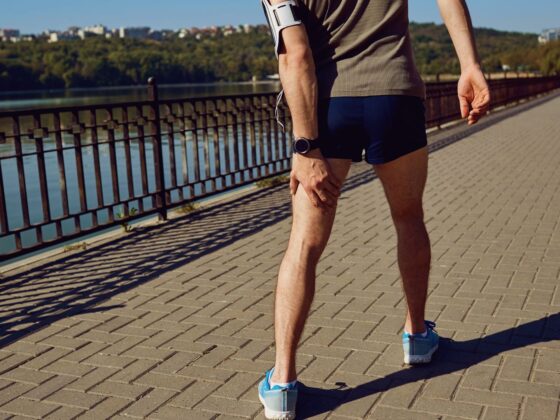
WHAT IS THE PLANTAR FASCIA AND FASCIITIS?
If you’re dealing with pain and stiffness in your heel and arch, you’ve probably heard the term “plantar fasciitis” used quite a bit. It’s one of the most common causes of heel pain that we see, with over 2 million Americans struggling with it every year(1). The plantar fascia is a thick fibrous band of connective tissue originating from the heel bone that extends along the sole of the foot towards the toes. It provides support for the foot’s arch, acts as a shock absorber, and aids with gait mechanics. It is typically described as sharp stabbing pain in the heel or arch area, often worse when taking the first steps in the morning or after long periods of sitting (2).

WHY PLANTAR FASCIITIS IS NO LONGER AN ACCURATE LABEL
Plantar fasciitis by definition, implies swelling and inflammation of that tissue. However, recent research found that only about 5% of cases actually show inflammation on imaging tests(4). There seem to be more factors at play than simply inflamed fascia. Other tissues can also be involved, which is why plantar heel pain has become a more popular diagnosis. It leaves room for other variables. The precise cause is often unknown, but plantar heel pain frequently results from repetitive strain and overuse dysfunction of multiple plantar structures including the fascia itself, the fat pad on the bottom of the foot, muscles, and nerves. Factors such as running, increased weight, or increased time spent on the feet are just a few possible contributors (3).

SO WHAT WE CALL IT A DIFFERENT NAME – HOW DO WE TREAT IT?
Bottom line, that deep heel and arch soreness stems from straining the fascia and structures around it way too much. It’s difficult to point to one exact mechanism for your pain, but there are plenty of options to get things feeling better!
Recent high-quality studies have evaluated rehabilitation strategies for plantar heel pain. Treatments now should emphasize progressive tissue loading and remodeling exercises rather than anti-inflammatory modalities. For example, a 2020 randomized trial demonstrated that plantar fascia-stretching using a towel or resistance band combined with calf and foot soft tissue massage led to decreased pain and improved function when compared to no treatment (5). The specific stretching targets and tension loads the plantar fascia itself, while massage techniques mobilize tight calf, arch, and plantar muscles. Other potentially helpful interventions include taping techniques to support the arch and reduce strain on the plantar fascia, dry needling, night splints, and relative rest/activity modification to avoid aggravating activities (7). Additional research supports use of prefabricated arch-support orthotics, which redistribute pressure away from irritated heel tissues out to the midfoot area (6). Orthotics worn during daily activities allow for graded loading and exercise progression.

WHAT PT CAN OFFER COMPARED TO MEDICAL INTERVENTIONS
It may be tempting to get a “quick fix” especially if the pain is really intense and impacting quality of life. It may come as no surprise that treatments like corticosteroid injections typically do not provide long-term benefit and do come with possible risks and side effects(8). Something more invasive like surgery should be the absolute last resort after 9-12 months if high-quality conservative treatment fails (7).
Physical therapists tailor and monitor the progressive loading process to stimulate tissue adaptation, while minimizing symptom flare-ups as best as possible. It is important that rehab strategies also consider the patient’s goals and lifestyle. Every patient is unique – what works for a 25 year old triathlete might not be best for a 68 year old retiree who wants to walk the golf course comfortably. Together we’ll get your foot feeling good based on your needs and goals. The ultimate goal is to coax those overloaded plantar tissues to remodel and repair themselves.
When addressing heel pain, it is crucial to identify and address the underlying cause of the pain. Often, heel pain can stem from impaired biomechanics or limited mobility in areas above the foot, such as the ankle, knee, hip, or even the lower back. Additionally, the pain may be a result of radicular pain caused by nerve impingement along the L5/S1 region.
Therefore, it is essential to receive treatment that not only targets the symptoms but also addresses the root cause of the pain. By doing so, you can achieve long-lasting relief and prevent further complications. Seeking comprehensive care that considers the entire kinetic chain and factors contributing to the heel pain will ensure that you receive effective and tailored treatment for optimal results.
While this may be all just semantics, calling it plantar fasciitis does get the point across. Just know it’s more of a “plantar heel pain” these days. But most importantly, we’ve got loads of ways to kick it to the curb!
Have you been diagnosed with plantar fasciitis or foot pain that just won’t go away? Schedule an appointment with one of our Doctors of Physical Therapy to get you back to doing the things you love! CLICK HERE or call 512-777-0330.
References:
1. Buchbinder R. Plantar Fasciitis. N Engl J Med. 2004;350(21):2159-2166. doi:10.1056/NEJMcp032745
2. Riddle DL, Pulisic M, Pidcoe P, Johnson RE. Risk factors for Plantar fasciitis: a matched case-control study. J Bone Joint Surg Am. 2003;85(5):872-877. doi:10.2106/00004623-200305000-00015
3. Wearing SC, Smeathers JE, Urry SR, Hennig EM, Hills AP. The pathomechanics of plantar fasciitis. Sports Med. 2006;36(7):585-611. doi:10.2165/00007256-200636070-00004
4. Lemont H, Ammirati KM, Usen N. Plantar fasciitis: a degenerative process (fasciosis) without inflammation. J Am Podiatr Med Assoc. 2003;93(3):234-237. doi: 10.7547/87507315-93-3-234.
5. Renan-Ordine R, Alburquerque-Sendín F, Rodrigues De Souza DP, Cleland JA, Fernández-de-Las-Peñas C. Effectiveness of myofascial trigger point manual therapy combined with a self-stretching protocol for the management of plantar heel pain: a randomized controlled trial. J Orthop Sports Phys Ther. 2011;41(2):43-50. doi:10.2519/jospt.2011.3504
6. Lee SY, McKeon P, Hertel J. Does the use of orthoses improve self-reported pain and function measures in patients with plantar fasciitis? A meta-analysis. Phys Ther Sport. 2009;10(1):12-18. doi:10.1016/j.ptsp.2008.09.002
7. Martin RL, Davenport TE, Reischl SF, et al. Heel pain-plantar fasciitis: revision 2014. J Orthop Sports Phys Ther. 2014;44(11):A1-A33. doi:10.2519/jospt.2014.0110
8. David JA, Sankarapandian V, Christopher PR, Chatterjee A, Macaden AS. Injected corticosteroids for treating plantar heel pain in adults. Cochrane Database Syst Rev. 2017;6(6):CD009348. Published 2017 Jun 29. doi:10.1002/14651858.CD009348.pub2
9. Sweeting D, Parish B, Hooper L, Chester R. The effectiveness of manual stretching in the treatment of plantar heel pain: a systematic review. J Foot Ankle Res. 2011;4:19. Published 2011 Jun 24. doi:10.1186/1757-1146-4-19




